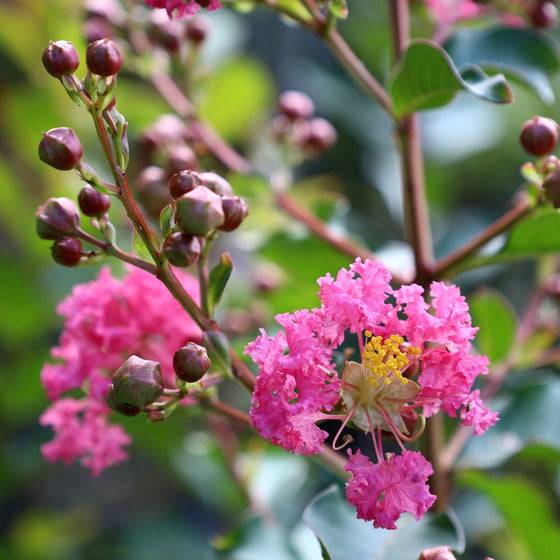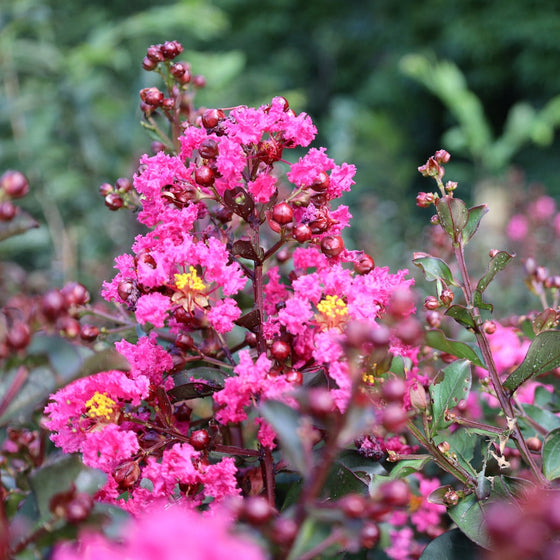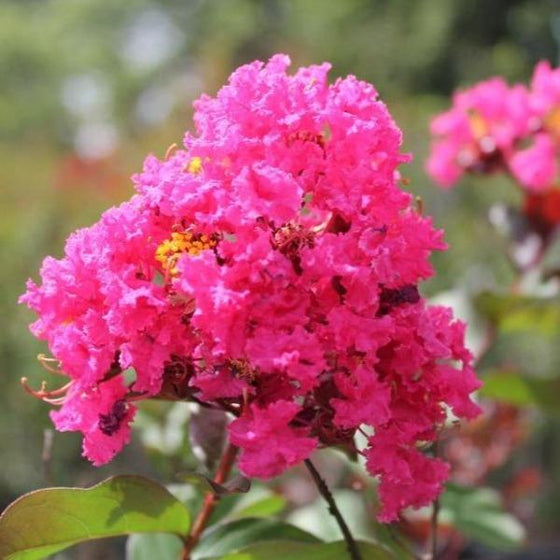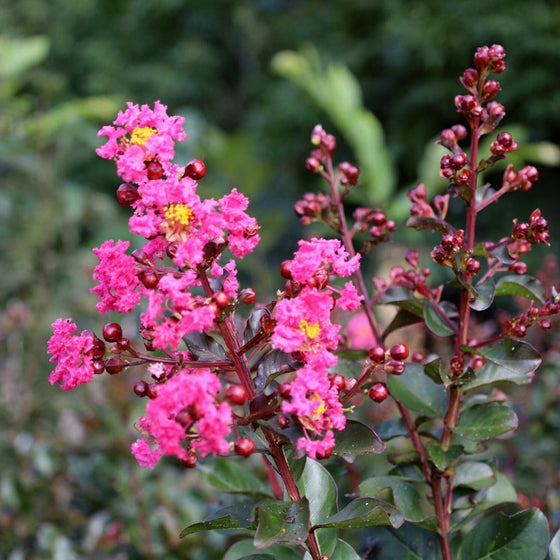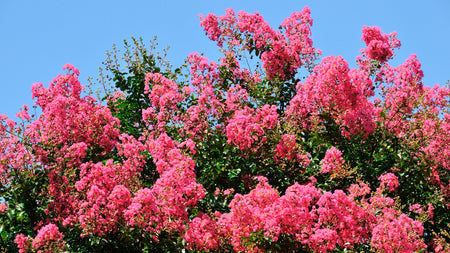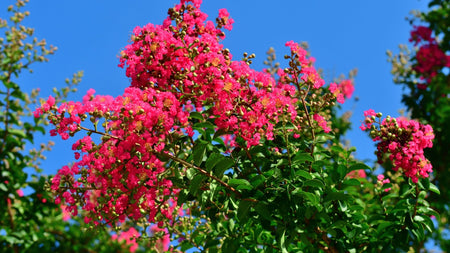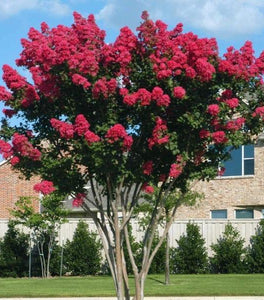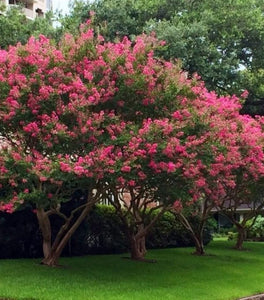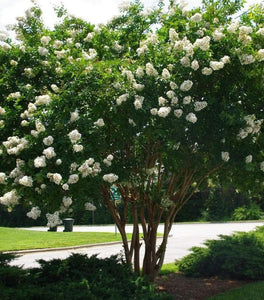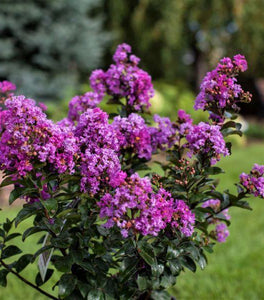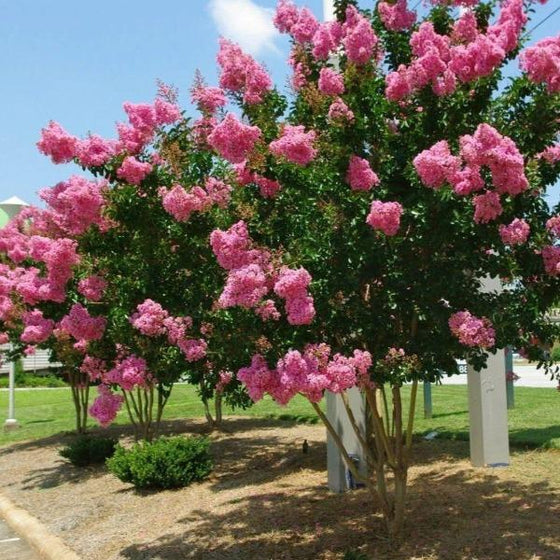
Images Depict Mature Plants
Pink Velour Crape Myrtle
Pink Velour Crape Myrtle is a striking ornamental shrub known for its deep pink, almost magenta flower clusters and rich burgundy-purple foliage that emerges in spring. As the season progresses, the foliage matures to a deep green, creating a stunning backdrop for its vivid summer blooms. This mid-size variety typically reaches 6 to 10 feet tall and wide, making it ideal for foundation plantings, small flowering trees, colorful hedges, or focal points in the landscape. Its extended bloom time, from mid-summer to fall, ensures long-lasting color and beauty in any sunny garden.
Bred for performance and visual impact, Pink Velour Crape Myrtle is exceptionally low maintenance and highly resistant to common issues like powdery mildew and leaf spot. It thrives in full sun and well-drained soil, and once established, it becomes impressively drought-tolerant—perfect for hot, dry climates and water-wise landscapes. Its upright, multi-stemmed form and naturally rounded habit require little pruning to maintain an elegant shape, making it a favorite among home gardeners and professional landscapers alike.
In addition to its ornamental value, Pink Velour Crape Myrtle also attracts pollinators such as bees and butterflies, enhancing the ecological health of your landscape. Its vibrant flowers provide a consistent nectar source during peak pollinator season, making it a beautiful and functional addition to pollinator gardens. Whether used as a specimen shrub, grouped in a colorful screen, or featured in mixed perennial beds, Pink Velour adds four-season interest and bold color to landscapes both large and small.

| Hardiness Zone: | 7-9 |
|---|---|
| Mature Height: | 8 to 10 feet |
| Mature Width: | 6 to 8 feet |
| Classification: | Tree form small to mid-sized (5 to 10 feet) |
| Sunlight: | Full Sun |
| Habit: | Deciduous, densely branched, multi-stemmed habit |
| Flower Color: | Bright Magenta Pink flowers |
| Foliage: | New growth emerges a deep wine red changing to deep purple-green, then changes again to a equally vibrant orange-red in the fall |
| Soil Condition: | Any well drained soil |
| Water Requirements: | Water well until established |
| Uses: | Extremely attractive when used as a focal point in the mixed border, mass planting, or a specimen planting. Also try them in large containers on the patio |
How to Care for Pink Velour Crape Myrtle
Before you buy a Pink Velour Crape Myrtle, make sure to read about the care instructions that are required and recommended to keep this plant healthy and flourishing.
How do I plant My Pink Velour Crape Myrtle?
To plant your Pink Velour Crape Myrtle, begin by choosing a location that receives full sun for at least six hours a day to ensure vibrant blooms and healthy growth. Dig a hole twice as wide as the root ball and just as deep, loosening the surrounding soil to encourage root expansion. Position the plant so the top of the root ball is level with the ground, then backfill with a mixture of native soil and organic compost. Firm the soil gently and water thoroughly to eliminate air pockets. Adding a 2–3 inch layer of mulch around the base helps retain moisture, regulate soil temperature, and suppress weeds—just be sure to keep the mulch a few inches away from the trunk. When planting Pink Velour Crape Myrtle, be sure to provide adequate space for its mature size of 6 to 10 feet tall and wide. This mid-size variety is ideal for creating vibrant hedges, stand-alone specimen plantings, or mixed shrub borders. If planting multiple Pink Velour shrubs, space them 6 to 8 feet apart to allow for proper air circulation and a full canopy of blooms. Water deeply during the first growing season to establish a strong root system. With the right planting site and care, Pink Velour Crape Myrtle will reward you with showy magenta blooms, deep foliage color, and exceptional garden performance.
How Should I Water my Crape Myrtle Pink Velour Trees?
When watering your Pink Velour Crape Myrtle, focus on deep, infrequent watering to promote strong, deep root growth. During the first growing season, water your shrub thoroughly once or twice a week, depending on weather conditions and soil drainage. Always water at the base of the plant to avoid wetting the foliage, which can help prevent fungal diseases like powdery mildew. Deep watering encourages the roots to grow downward, which is key to developing drought tolerance and long-term resilience in the landscape. Once established, Pink Velour Crape Myrtle is relatively drought tolerant and typically only needs supplemental watering during extended dry periods. Check the soil about 2 inches below the surface—if it feels dry, it’s time to water. Applying a 2–3 inch layer of mulch around the base of the plant can help conserve moisture, regulate soil temperature, and reduce the need for frequent watering. With proper watering practices, your Pink Velour Crape Myrtle will remain healthy and vibrant, showcasing brilliant magenta blooms and lush foliage throughout the summer season.
How should I Fertilize My Pink Velour Crape Myrtle?
To fertilize your Pink Velour Crape Myrtle, apply a balanced, slow-release fertilizer such as 10-10-10 or 12-4-8 in early spring, just as new growth begins. Spread the fertilizer evenly around the root zone, keeping it several inches away from the trunk, and water it in thoroughly to help the nutrients absorb into the soil. This early-season feeding encourages healthy leaf development, strong branching, and a vibrant flush of magenta blooms that Pink Velour is known for. Avoid high-nitrogen fertilizers, which can lead to excessive leafy growth at the expense of flowering. For continued performance, you can apply a second light feeding of fertilizer in midsummer, especially if the plant is growing in poor soil or if blooming slows down. Alternatively, enriching the soil with compost or organic mulch can provide slow, consistent nourishment throughout the season. Always follow the fertilizer manufacturer's instructions to avoid overfeeding, which can stress the plant and reduce flower production. With a consistent, well-timed fertilization routine, Pink Velour Crape Myrtle will thrive in your landscape, offering months of bold color and vigorous, healthy growth.

How and When should I Prune My Pink Velour Crape Myrtle?
You should prune your Pink Velour Crape Myrtle in late winter or very early spring, before new growth begins to emerge. This is the ideal time to shape the shrub and remove any dead, damaged, or crossing branches without cutting off developing flower buds, which form on new wood. Use clean, sharp pruning shears to thin out crowded areas, improve air circulation, and maintain its naturally rounded, upright form. Since Pink Velour has a compact, multi-stemmed habit, only light pruning is typically needed to keep the plant healthy and blooming at its best. When pruning your Pink Velour Crape Myrtle, avoid cutting back the main trunks severely—a practice known as “crape murder”—as it can lead to weak regrowth and fewer blooms. Instead, focus on enhancing the shrub’s natural shape and removing any suckers from the base. During the summer, you can also deadhead spent blooms to encourage a second flush of vivid magenta flowers. With proper seasonal pruning, your Pink Velour Crape Myrtle will maintain its structural integrity, support heavy blooming, and continue to be a striking focal point in your landscape year after year.

